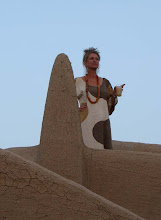
Monsieur Ahmed Bacaina Traoré, Kintigi (neighbourhood chief) of the district of Kanafia, Djenné. His collection is large and part of it was shown to the team: 853 MSS are listed. M. Traoré donated oneKoran to the Library.
Our archivists did not make any speculation as to the age or importance of any particular document. They noted that the oldest dated manuscript found in the Djenné Library was a Grammar from 1631. Many manuscripts may be much older since dating is not common.
There were a number of MSS that were noted because they were unusual: a manuscript dealing with theology in the Fulani language but written with Arabic script; A Tariq (History) of Macina, a Malian town of historical importance; a document dealing with traditional medicine from Mauretania; a biography of Fulani men of letters; A History of the Fulani people; a copy of the Tariq es Soudan, an account of commercial connections between Djenné and Libya and Tunisia and a census of the Sankoré district of Djenné.
The Timbuktu Archivist Samba noted that there was a difference between the MSS of Djenné and those of Timbuktu in that there were a much larger proportion of documents dealing with the subject of magic in Djenné. Roughly half of all the new MSS viewed were entered under the heading ‘Esotericicm’. Samba Ibrahim assured me that this meant, in this context, magic. This is not unexpected, because Djenné has had, and still has, a reputation for witch craft and maraboutage. Samba also noted that the people of Djenné showed a high level of suspicion and were worried about showing their documents. They did not understand why the team was interested in just seeing the MSS, and feared perhaps that they would be stolen, hence their insistence on being present at the viewings. But Samba also said that the archivists had encountered this sort of resistance in the beginning in Timbuktu too, and Haidara agreed that it was to be expected.
The archivists agree in their opinion that the MSS shown to the team are incomplete in almost all cases. During the visits it became clear that many manuscript owners were willing to show only a fraction of their collection, sometimes indicating that they would be willing to show more at a later date. Often several large chests full of manuscripts remained unopened. It is likely that the MSS shown are not the ones regarded as the most important. There are also many more families in possession of MSS, who have not yet agreed to invite the team, although promises have been given in many cases, either to donate to the Library or to allow access in their homes at a later date.
There was a certain resistance to the project because it was perceived that those who took part by opening their doors and their collections should in some way receive a remuneration. It is therefore remarkable that so many families, many of them so poor that they are not always able to eat their fill, should have agreed to take part, and even to donate to the library although they received nothing.


0 Comments:
Post a Comment
<< Home